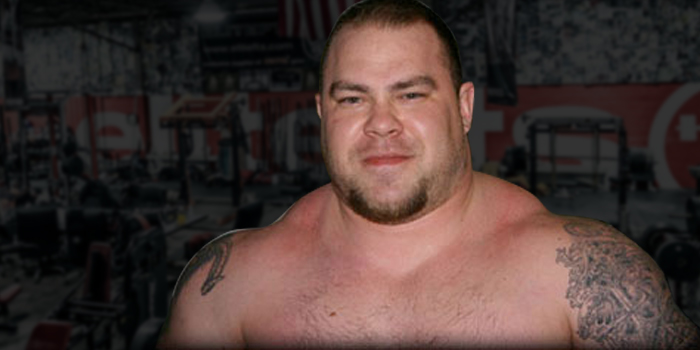
elitefts Classic
The importance of the yoke was brought to my attention when I was a junior at Wheeling High School in Wheeling, Illinois. I was sitting in English class when Alison Kopec, who was sitting directly behind me, grabbed my traps, gave them a thorough rubbing and complimented me on their size. She did so with a certain amount of sexiness and purpose that whispered, “Let’s get it on.” This is when I realized that having a big yoke could potentially lead to some dirty carnality. It never did, but I haven’t won the lottery either, and I’m still playing. From then on, I’ve been a proponent of building a massive yoke. But it wasn’t until later that the term, “yoke” would become part of the EFS vernacular.
Fast forward 14 years. Dave and I are getting measured for dress shirts. I’m about to get married and neither of us have a shirt to wear. Nothing fits off of the shelf so we bring someone to the EFS Compound to measure us. As the guy is measuring us, we notice that one measurement involves going from shoulder to shoulder, with the tape measure being brought over the traps. He mentions that this measurement is the “yoke”. Dave and I compare measurements and I’m happy to say that I came out WAY on top. It was such a crushing defeat that we had to console Dave for a week. It was not an enjoyable week at the Compound, but I was secretly smiling. I was King Yoke @ EFS.
What is the yoke?
The yoke is comprised of several different muscles, none of which I know the technical names of. So to save face and to speak the language of most of my constituents, the yoke is the traps, rear delts and the neck. Of course, the traps are the most popular faction of the yoke, but it cannot survive without the neck and the rear delts. They must co-exist.
So why would you want a big yoke?
Besides the possibility of a large yoke getting you some nighttime nummsies (which should be enough to convince any man), the yoke is the basis on which you will be judged. This may seem like a harsh statement, but let’s face the facts. We live in a society that judges on physical appearance. Having big legs is ok, but no one notices. Big arms make you seem too narcissistic. A big chest makes you look like Captain UpperBody; a superhero no one wants to dress up like during Halloween. So that leaves the yoke as the essential body part to develop.
I have said this a million times before; a big yoke = instant respect. No one wants to screw with a guy that has a big neck and a thick yoke. A massive yoke smells of hard work, strength, fighting and toughness. Every other muscle can be small if a big yoke is present.
So here are my rules to a big yoke. And to the doubters, look above to see a picture of me and my yoke. Aren’t I cute?
Yoke Rule #1: Train Heavy
The history behind the development of the yoke started in the 8th grade. This is when I started to train. I didn’t know how to train but I did train heavy. This is the key component of being beefy. You cannot build a big, thick, and impressive yoke handling weights that would be called “pink” if they were a color. Your training has to revolve around heavy squats, benches, and deadlifts. This is nothing that hasn’t been said before, but should always be reiterated. This is the most important rule if you want to go to Yoke State University.
Yoke Rule #2: Deadlift
If you were to put me on a deserted island and allowed me to do one exercise, I would pick the deadlift. Also, since I suck at the deadlift no one would see how bad I was at it. No other lift works more muscles than the deadlift. The irony is that few people do this lift and when they do, it’s “for reps” or for “form work” so they don‘t hurt their back. These terms are code for “pussy”. Yes, I did just say that, but let’s be honest and call a spade a spade. So you must pull and you must pull heavy.
Yoke Rule #3: Hang Cleans/Snatches
I know some people aren’t keen on the Olympic lifts, but they are gold when developing the yoke. While the Power Clean/Power Snatch are OK, the “hang” versions are much better. This is because most people will use more upper body when doing hang cleans or hang snatches. I recommend doing them one time a week, for 3-5 sets of 3-5 reps. Don’t be afraid to use straps. The Olympic lifts were a big part of my program for a number of years and I credit them for building the foundation of a proper Yoke. Don’t be afraid to try clean grip snatches.
Yoke Rule #4: Neck work
I’m a card carrying member of the Neckwork Network. I think every man should be doing neck work, regardless of sport. No one wants to have a stack of dimes holding their head in place. It’s embarrassing. As for exercises, I’m not a big fan of neck bridges as they seem unsafe and every time I see someone doing them I have this intense urge to kick their heads out from underneath them. Since I know I’m not the only that thinks like that, I’ll play it safe and stick to the neck harness and the 4-way neck machine. Now let me bestow some wisdom on you; don’t try to max out on these exercises. I tried putting a 100-pound dumbbell on the neck harness and after a couple of reps felt an intense pain in my neck. Not a good thing. When training the neck, either with the neck harness or the 4-way neck machine, stick to higher reps, 10-30 reps. I like to do neck work after each workout. When I was lugging the pigskin for the University of Arizona, I would do two sets of neck work every morning and two sets before I went to bed. I put my neck harness beside my bed as a constant reminder. I did sets of 30 reps. Bottom line; do some neck work or be doomed to a life of buying off the shelf.
Yoke Rule #5: Shrugs
Shrugs are the most common and popular yoke exercise and for good reason. They are easy to do and they work. I have done my fair share of shrug variations and found that each one of them is unique and special. Here are some of my favorites:
- Barbell Shrugs
- DB Shrugs
- Trap Bar Shrugs
- Fat Bar Shrugs
- Power Squat Shrugs
- Safety Squat Bar Shrugs
- Chest Supported Row Shrugs
- Power Shrugs
The key to doing the shrugs (as with all exercises) is to maintain good form. Reps should fall between 6-20. Don’t be afraid to do some high reps with them.
Yoke Rule #6: Upright Rows
Now I know some people laugh at this one, but they are weak and pathetic, so pay no mind to their chuckles. Upright rows were a staple of my training for many years and I recently brought them back. After a recent upright row session, my wife commented on the new growth of my traps so I know these work. I don’t like doing these too heavy as they hurt my shoulder sometimes and my form goes in the dumper. These are done for higher reps, 10-15.
Yoke Rule #7: The Others
There are several other exercises other than the ones listed above that can contribute to a massive yoke. These include: face pulls, rear delt raises, seated dumbbell power cleans, chest supported rows, pull-ups/chin-ups, and barbell/dumbbell rows. All have a contributing factor to the growth of the yoke, but you can survive without them. Now there are no more excuses for having a small yoke. This is not something that can be developed overnight. The maturation of the yoke takes time. Be patient and the rewards will be great.









